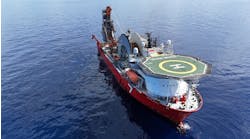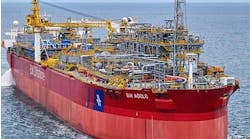Acoustic positioning systems have long been acknowledged as the best way to keep dynamically positioned (DP) vessels accurately on station in shallow water and are widely used in the oil fields of the Pacific Rim. The shift of operations to deeper water has created a challenge with older, acoustically noisy rigs.
The key acoustic positioning tool is the ultra short baseline (USBL) system that calculates range and bearing from hull-based transceivers to seabed transponders. It is now possible for acoustic positioning to be used as the prime input for the DP controller in the deepest water.
When vessels are operating in deepwater, the basic problem is the distance between the seabed and the surface. An acoustic transponder beacon on the seabed becomes harder to hear because its signals are affected by "spherical spreading." The sound disperses in all directions through the water.
Diminishing intensity
The extent of this decline in audibility is governed by a general rule that states that as the depth is doubled the sound intensity drops by three-fourths. Water temperature and pressure also have a variable effect upon the audibility
of acoustic signals and the resultant sound absorption is most pronounced with higher frequency signals.
Even in perfect conditions, the combined effects of distance as manifested by spherical spreading and sound absorption can make a transponder on the seabed 2,000 meters below a drilling rig extremely difficult to hear. If that signal must also compete with the noise of the rig's DP thrusters, it can be like "trying to hold a romantic telephone conversation at an Alice Cooper concert," according to one technician.
A major rig operator approached Sonardyne a year ago when it realized that the company had a potentially expensive problem on its hands. It had become apparent that unless the operator could devise an effective solution to their noisy rig, the only options would be to use either expensive high power transponders or carry out a major refit to the vessel and install quieter thrusters.
This would require installing fixed pitch, variable speed thrusters in the place of the noisier fixed speed, variable pitch thrusters. Fixed speed thrusters create a considerable amount of acoustic intrusion with high frequency sound generated by water aeration from the propellers, which turn continuously.
The compromise
In the practical world of offshore engineering, the achievement of precise acoustic positioning is ultimately a compromise between audibility and accuracy. The systems used for dynamic positioning operate in the middle range at around 25 kHz. This frequency is low enough to overcome the worst effects of absorption in deepwater, yet high enough to permit precise positioning.
Within this band, higher frequency acoustic signals provide the precision needed and an improvement of around 20% in repeatability when compared with lower frequencies. The medium frequency band is not quite high enough, however, to be beyond the effects of thruster noise.
The listening area of Sonardyne's standard transceiver head extends as a hemisphere reaching in all directions from the bottom of the vessel. Because of this, it cannot avoid sound input from the thrusters, which being only a few meters away and at roughly the same level, are simply too noisy to be ignored. Sonardyne's development engineers therefore decided that the simplest option was to direct the attention of their transceiver away from the thrusters in the first place.
This solution evolved into Sonardyne's Big Head transceiver unit designed to listen directly downwards in a cone extending 50° from the vertical. This means that it is not picking up excessive noise from the vessel thrusters, and in deepwater, it is monitoring a huge area of the seabed directly below. Because of this, the transceiver is able to achieve a better signal-to-noise ratio.
The system can provide positioning relative to transponders on the seabed, on remotely operated vehicles, or on riser angle monitors, all of which are important applications for this new technology. The improved acoustic reception makes it realistic to use conventional lower power transponders, which, because they bring significant improvements in battery life, can have a noticeable effect upon operating costs.
When they were designing a standard transceiver head seven years earlier, Sonardyne engineers also decided to improve positioning accuracy. They realized that the principal constraint in an ultra-short base line acoustic system is the physical law that requires receiver transducers to be no more than half an acoustic wavelength apart. This is physically around 30 mm and is essential to provide the unambiguous phase discrimination needed to calculate the signal range. Although positioning accuracy is improved, the further the receiver transducers can be spaced apart, the half wavelength rule appeared to dictate an upper limit on achievable performance.
However, the use of advanced ambiguity algorithms in the standard Sonardyne transceiver head allowed the transducers to be spread further apart than the half wavelength limit would otherwise allow.
When they began work on the new deepwater transceiver, the Sonardyne team then realized that a pentagon configuration would introduce further benefits. By using five receiving transducers in the Big Head, the design serves to create a space in the center of the pentagon that can be occupied by the transmitter.
With the system, it is possible to use the advanced ambiguity resolution algorithms and achieve an additional 33% of transducer spread for improved accuracy. The layout also provides for the use of transducers that are optimized for transmitting or receiving. The system permits use of larger elements, which operate in the lower end of the MF frequency band and are better suited to noise rejection.
The development required the search for ceramic materials and mounting techniques that did not generate resonances below 34 kHz. Repeated trials were conducted in test tanks at Sonardyne's factory in Hampshire, England, until an ideal combination was found. The unit has an outside diameter of 11.81 in.
The first units were fitted aboard two rigs working in deepwater offshore Brazil and West Africa. There, they are providing sub-meter positioning accuracy on vessels that would otherwise be unable to operate in such depths due to the noise of their thrusters. Another system is being used by a survey company for ROV tracking in over 5,000 meters water depth.


